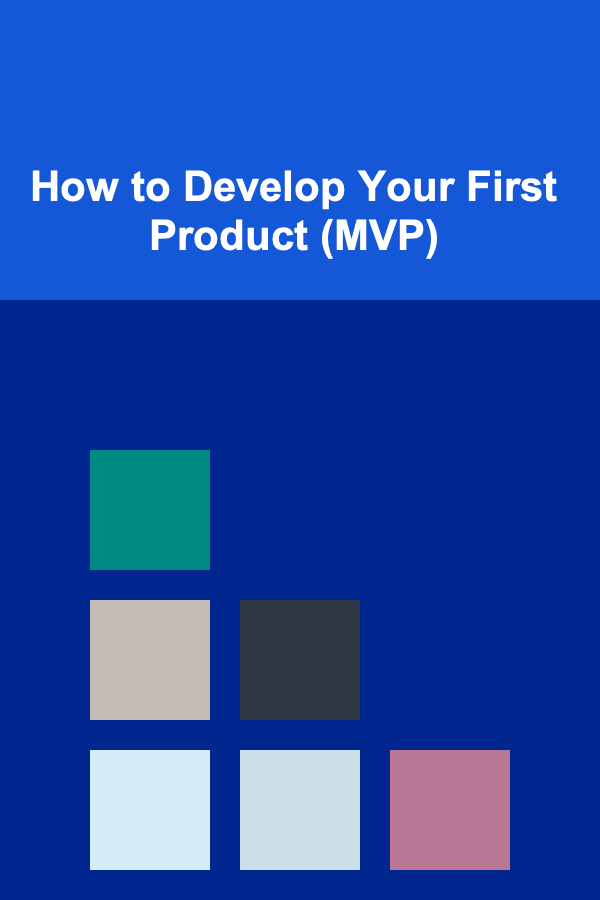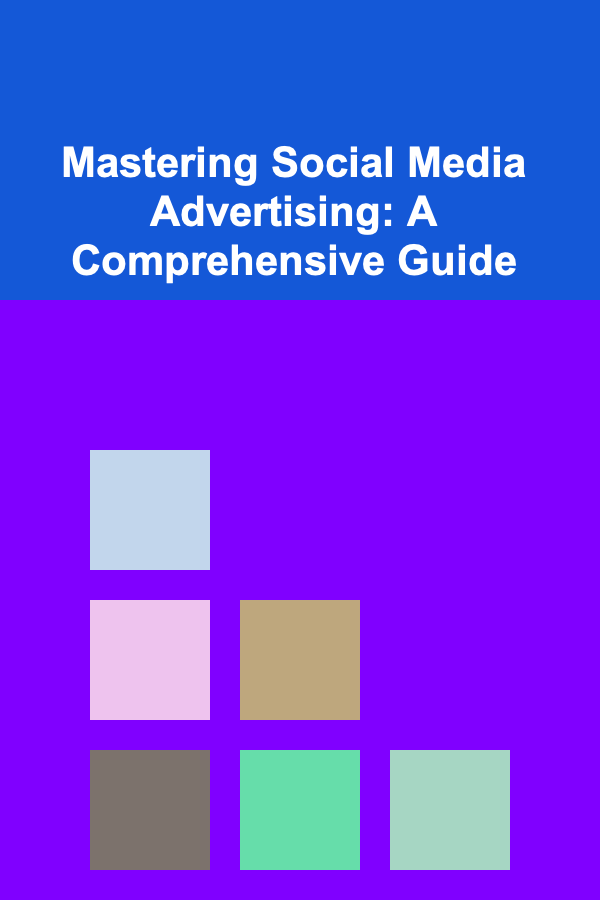
How to Develop Your First Product (MVP)
ebook include PDF & Audio bundle (Micro Guide)
$12.99$10.99
Limited Time Offer! Order within the next:

Developing your first product can be an exhilarating yet daunting experience. The journey from idea to a tangible product is filled with challenges, learning opportunities, and moments of pure excitement. One of the most effective strategies for launching a successful product, especially when resources are limited, is to focus on building a Minimum Viable Product (MVP). This article will delve deep into the process of developing your first MVP, covering everything from validating your idea to iterating based on user feedback.
Understanding the MVP Concept
At its core, an MVP is a version of your product with just enough features to attract early-adopter customers and validate a product idea early in the product development cycle. It's not about building a perfect, fully-featured product from the outset. Instead, it's about creating a functional prototype that solves a core problem for a specific target audience and allows you to gather valuable feedback for future iterations.
The term "Minimum Viable Product" was popularized by Eric Ries in his book "The Lean Startup." Ries emphasizes the importance of validated learning and rapid iteration. The MVP approach aligns with this philosophy by enabling you to test your assumptions, learn from your mistakes, and refine your product based on real-world data, rather than relying on guesswork or gut feelings.
Think of it this way: Instead of building a full-fledged car (with all the bells and whistles), you start with a skateboard, then a scooter, then a bicycle, and finally a motorcycle before building the car. Each stage provides a minimal yet usable solution to the core problem of transportation, allowing you to learn and adapt as you go.
Why Build an MVP?
There are several compelling reasons to embrace the MVP approach:
- Reduced Risk: Building a full-fledged product without validating its market demand is a risky endeavor. An MVP allows you to test the waters and determine whether there's genuine interest in your solution before investing significant time and resources.
- Faster Time to Market: By focusing on essential features, you can launch your product much faster, allowing you to gain a competitive advantage and start generating revenue sooner.
- Cost-Effectiveness: Developing an MVP requires significantly less investment than building a complete product. This is especially crucial for startups and businesses with limited budgets.
- User Feedback and Iteration: The primary goal of an MVP is to gather feedback from real users. This feedback is invaluable for identifying areas for improvement, prioritizing features, and ensuring that your product aligns with market needs.
- Attracting Early Adopters: MVPs often appeal to early adopters who are willing to try new and innovative products. These users can provide valuable insights and become advocates for your brand.
- Avoiding Feature Creep: By focusing on core functionality, you can avoid the trap of adding unnecessary features that don't contribute to the core value proposition of your product.
Step-by-Step Guide to Developing Your First MVP
Now that you understand the importance of building an MVP, let's explore a step-by-step guide to developing your first product:
1. Idea Validation and Market Research
Before you start coding, it's crucial to validate your idea and conduct thorough market research. This involves determining whether there's a genuine need for your product, identifying your target audience, and analyzing your competitors.
- Define Your Problem Statement: Clearly articulate the problem that your product aims to solve. Who is experiencing this problem, and how is it currently being addressed? The more specific you are, the better. For example, instead of "People need a better way to manage their tasks," try "Busy professionals struggle to prioritize and track their daily tasks effectively, leading to missed deadlines and increased stress."
- Identify Your Target Audience: Who are your ideal customers? What are their demographics, interests, and pain points? Creating detailed user personas can help you visualize your target audience and tailor your product to their specific needs.
- Competitive Analysis: Research existing solutions in the market. What are their strengths and weaknesses? How can your product differentiate itself and offer unique value? Look beyond direct competitors to identify indirect substitutes that address the same problem.
- Market Size and Potential: Estimate the potential market size for your product. Is there enough demand to sustain a viable business? Consider factors such as market growth, trends, and regulatory environment.
- Customer Interviews and Surveys: Talk to potential customers and gather feedback on your idea. Conduct surveys to collect quantitative data and identify key pain points. Ask open-ended questions to encourage detailed responses and uncover unexpected insights. Tools like SurveyMonkey, Google Forms, and Typeform can be helpful for creating and distributing surveys.
- Landing Page with Sign-Up Form: Create a simple landing page that describes your product and its benefits. Include a sign-up form to gauge interest and collect email addresses. This allows you to build a list of potential customers and keep them informed about your progress. Platforms like Launchrock and Unbounce are designed for creating landing pages quickly.
2. Define Your MVP Features
Based on your market research, identify the core features that are essential for solving the problem you're addressing. Prioritize features that provide the most value to your target audience and are feasible to develop within a reasonable timeframe and budget.
- Prioritize Features: Use a framework like the MoSCoW method (Must have, Should have, Could have, Won't have) or the Kano model to prioritize features based on their impact and feasibility. Focus on the "Must have" features for your MVP.
- User Stories: Write user stories to describe how users will interact with your product and the benefits they will derive. Each user story should follow the format: "As a [user type], I want to [perform this action] so that [I can achieve this benefit]." For example, "As a busy professional, I want to be able to create tasks with deadlines so that I can stay organized and meet my deadlines."
- Focus on Core Functionality: Resist the temptation to add unnecessary features. Stick to the core functionality that solves the problem you're addressing. Remember, you can always add more features in future iterations.
- Document Your Requirements: Create a clear and concise document that outlines the features, functionality, and user experience of your MVP. This document will serve as a guide for your development team.
3. Choose Your Technology Stack
Selecting the right technology stack is crucial for building a scalable and maintainable product. Consider factors such as your team's expertise, budget, and the specific requirements of your project.
- Frontend Technologies: Choose a frontend framework or library for building the user interface. Popular options include React, Angular, and Vue.js. Consider the learning curve and the availability of resources for each technology.
- Backend Technologies: Select a backend programming language and framework for handling server-side logic and data management. Common choices include Node.js, Python (with Django or Flask), Ruby on Rails, and Java (with Spring).
- Database: Choose a database for storing your application's data. Popular options include relational databases like PostgreSQL and MySQL, and NoSQL databases like MongoDB and Cassandra. Consider factors such as scalability, performance, and data consistency requirements.
- Cloud Platform: Consider using a cloud platform like AWS, Google Cloud Platform, or Azure for hosting your application. These platforms offer a wide range of services, including computing, storage, and networking.
- DevOps Tools: Implement DevOps practices to automate the build, deployment, and monitoring of your application. Tools like Docker, Kubernetes, and Jenkins can help streamline your development process.
- Consider a "No-Code" or "Low-Code" Approach: For some MVPs, especially those focused on simple workflows or data collection, consider using no-code or low-code platforms like Bubble, Webflow, or Airtable. These platforms allow you to build functional prototypes without writing code, significantly accelerating the development process. However, be aware of the limitations of these platforms and ensure they can scale as your product evolves.
4. Design and User Experience (UX)
Even though it's an MVP, a good user experience is essential for attracting and retaining early adopters. Focus on creating a simple, intuitive, and user-friendly interface.
- User Research: Conduct user research to understand your target audience's needs and preferences. This can involve user interviews, surveys, and usability testing.
- Wireframing and Prototyping: Create wireframes and prototypes to visualize the user interface and test different design concepts. Tools like Figma, Sketch, and Adobe XD are commonly used for this purpose.
- User Interface (UI) Design: Design a visually appealing and consistent user interface that aligns with your brand. Pay attention to typography, color palettes, and visual hierarchy.
- Usability Testing: Conduct usability testing to identify and fix any usability issues. Ask users to complete specific tasks and observe their behavior.
- Keep it Simple: Avoid clutter and unnecessary elements. Focus on creating a clean and intuitive interface that is easy to navigate.
- Mobile-First Approach: If your target audience primarily uses mobile devices, consider adopting a mobile-first approach to design.
5. Development and Testing
Once you have a clear understanding of your MVP features and design, it's time to start development. Follow agile development principles and prioritize continuous integration and continuous delivery (CI/CD).
- Agile Development: Break down your project into smaller, manageable sprints. Hold daily stand-up meetings to track progress and address any roadblocks.
- Code Quality: Write clean, well-documented code that is easy to maintain and extend. Follow coding standards and best practices.
- Unit Testing: Write unit tests to verify the functionality of individual components. This helps to catch bugs early and ensure the stability of your code.
- Integration Testing: Test the integration between different components to ensure that they work together seamlessly.
- User Acceptance Testing (UAT): Involve your target audience in the testing process. Ask them to test your product and provide feedback.
- Continuous Integration and Continuous Delivery (CI/CD): Automate the build, testing, and deployment process. This allows you to release new features and bug fixes more frequently.
- Version Control: Use a version control system like Git to track changes to your code and collaborate with other developers.
6. Launch and Gather Feedback
Once your MVP is ready, it's time to launch it and start gathering feedback from users. Promote your product through social media, online communities, and other channels.
- Choose a Launch Strategy: Consider a phased launch to gradually introduce your product to a wider audience. This allows you to monitor performance and address any issues before scaling up.
- Promote Your Product: Use social media, online communities, and other channels to promote your product. Create engaging content that highlights the benefits of your product and targets your ideal customers.
- Collect User Feedback: Implement mechanisms for collecting user feedback, such as in-app surveys, feedback forms, and user interviews.
- Track Key Metrics: Monitor key metrics such as user engagement, conversion rates, and customer satisfaction. This data will help you understand how users are interacting with your product and identify areas for improvement.
- A/B Testing: Conduct A/B tests to compare different versions of your product and identify the most effective designs and features.
- Be Responsive: Respond to user feedback promptly and address any issues or concerns. This shows that you value your users and are committed to improving your product.
7. Iterate and Improve
The MVP is just the beginning. Based on the feedback you receive, iterate on your product and add new features. Continue to monitor your metrics and adapt your strategy as needed.
- Prioritize Feedback: Categorize and prioritize user feedback based on its impact and frequency. Focus on addressing the most critical issues first.
- Plan Your Next Iteration: Based on the feedback you receive, plan your next iteration of the product. Identify the features and improvements you will implement.
- Release New Versions: Release new versions of your product regularly to address bugs, add new features, and improve the user experience.
- Continue to Monitor Metrics: Continue to monitor your metrics and track the impact of your changes. This will help you determine whether your iterations are effective and identify areas for further improvement.
- Embrace Agile: Maintain an agile mindset and be prepared to adapt your strategy as needed. The market is constantly changing, so it's important to be flexible and responsive.
- Don't Be Afraid to Pivot: If your initial hypothesis proves to be incorrect, don't be afraid to pivot and change direction. The goal is to build a product that solves a real problem for a specific target audience. If your current approach isn't working, it's better to change course than to continue down a dead end.
Common Mistakes to Avoid
Developing an MVP can be challenging, and it's easy to make mistakes along the way. Here are some common pitfalls to avoid:
- Building Too Much: Resist the temptation to add too many features to your MVP. Focus on the core functionality and avoid feature creep.
- Ignoring User Feedback: Don't ignore user feedback. It's the most valuable source of information for improving your product.
- Lack of Market Research: Failing to conduct thorough market research can lead to building a product that no one wants.
- Poor User Experience: Even though it's an MVP, a good user experience is essential for attracting and retaining early adopters.
- Lack of a Clear Value Proposition: Make sure your product has a clear value proposition that resonates with your target audience.
- Not Tracking Metrics: Failing to track key metrics can make it difficult to measure the success of your MVP and identify areas for improvement.
- Premature Scaling: Scaling up before validating your product's market demand can be a costly mistake.
Conclusion
Developing your first product is a challenging but rewarding journey. By embracing the MVP approach, you can reduce risk, accelerate time to market, and build a product that truly meets the needs of your target audience. Remember to focus on validating your idea, defining your core features, building a simple and intuitive user interface, and gathering feedback from users. Iterate and improve your product based on the feedback you receive, and don't be afraid to pivot if necessary. With careful planning, execution, and a willingness to learn, you can successfully launch your first product and achieve your entrepreneurial goals.

How to Build a Checklist for Checking Website Functionality
Read More
How to Save Space in Your Dining Area with Compact Furniture
Read More
How to Use Deep Learning for Predictive Analytics and Earn Passive Income
Read More
How to Use Thrifted Frames to Add Style to Your Home
Read More
Unlocking Your Full Potential as a Call Center Representative: A Personal Development Journey
Read More
Mastering Social Media Advertising: A Comprehensive Guide
Read MoreOther Products

How to Build a Checklist for Checking Website Functionality
Read More
How to Save Space in Your Dining Area with Compact Furniture
Read More
How to Use Deep Learning for Predictive Analytics and Earn Passive Income
Read More
How to Use Thrifted Frames to Add Style to Your Home
Read More
Unlocking Your Full Potential as a Call Center Representative: A Personal Development Journey
Read More